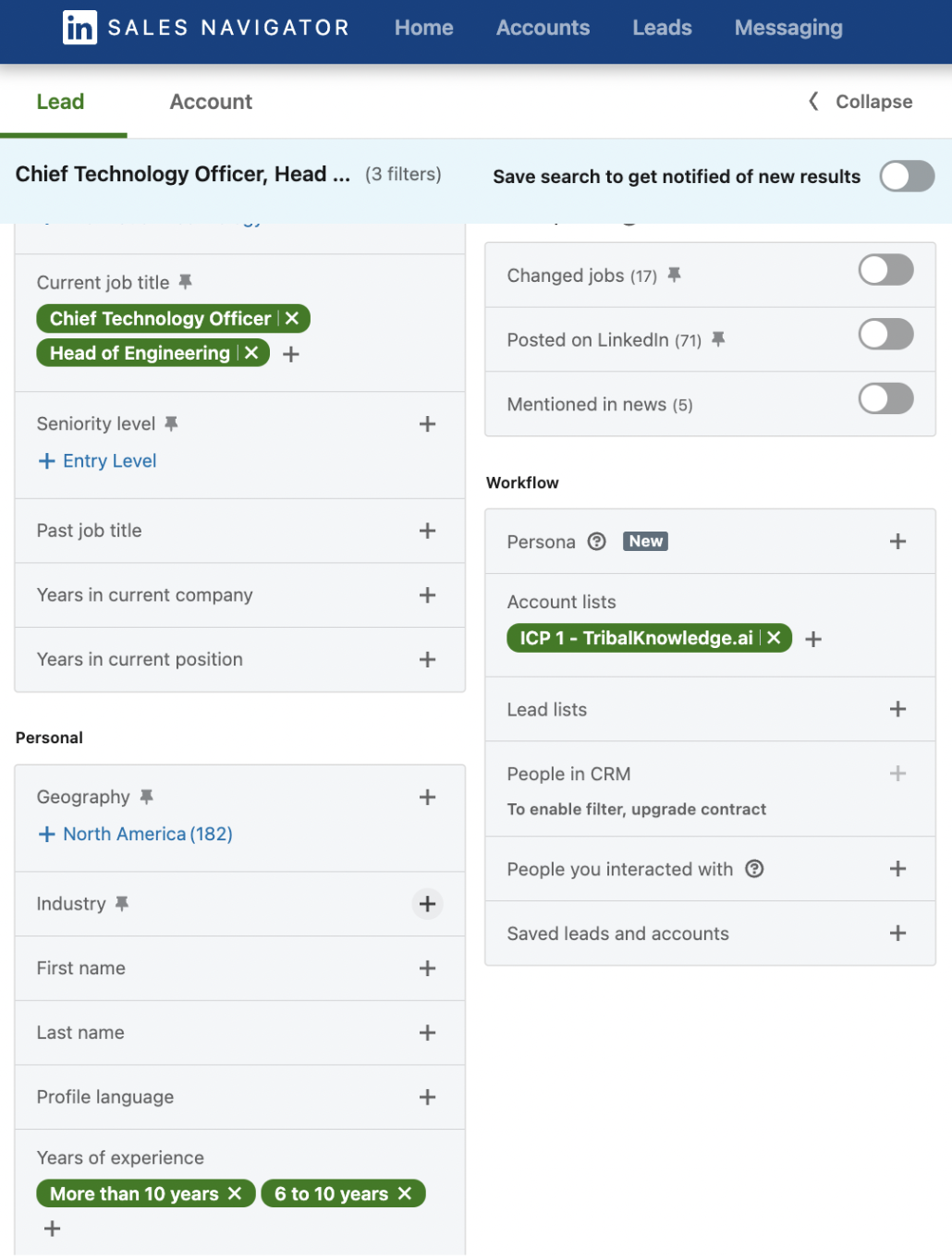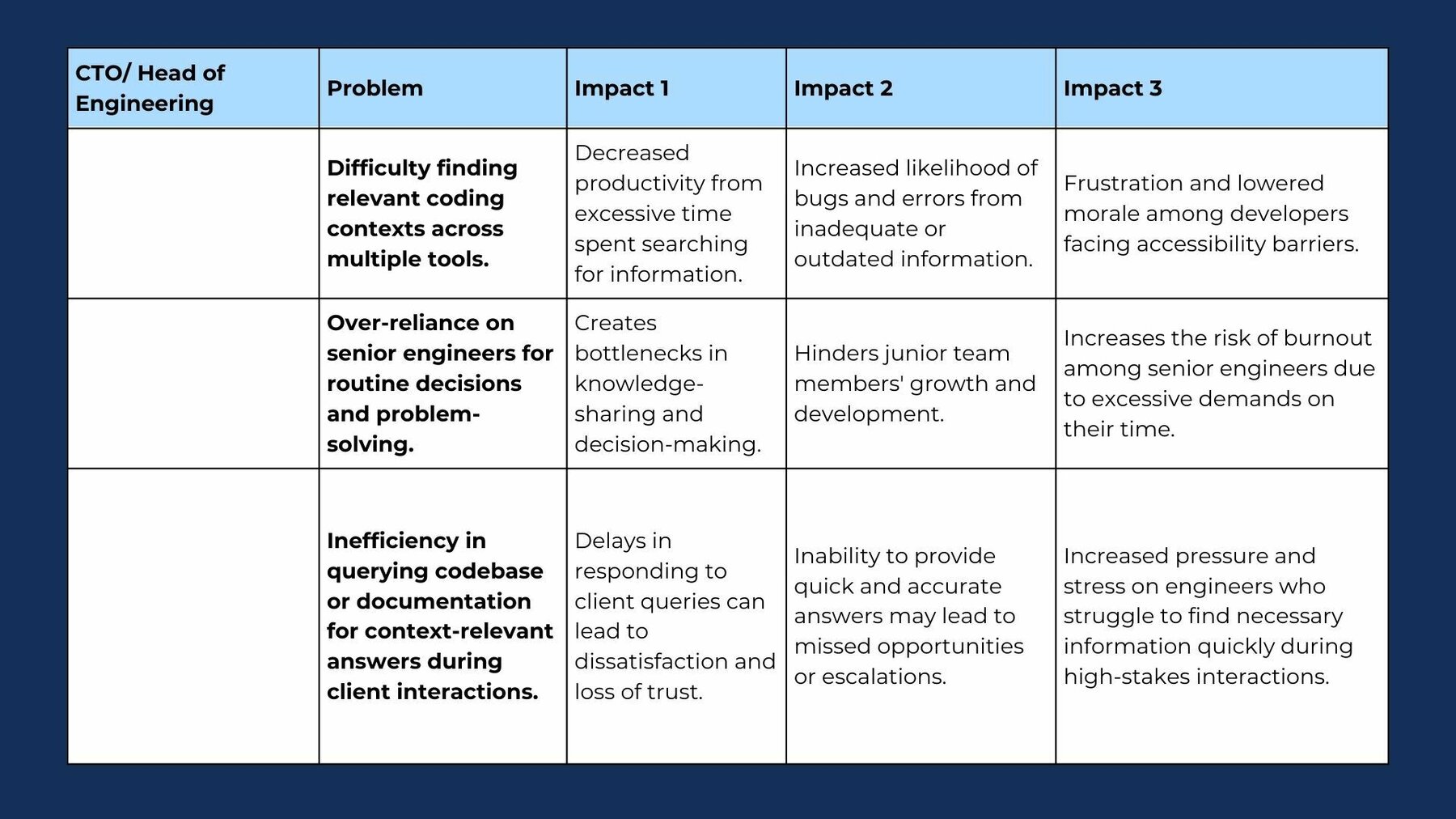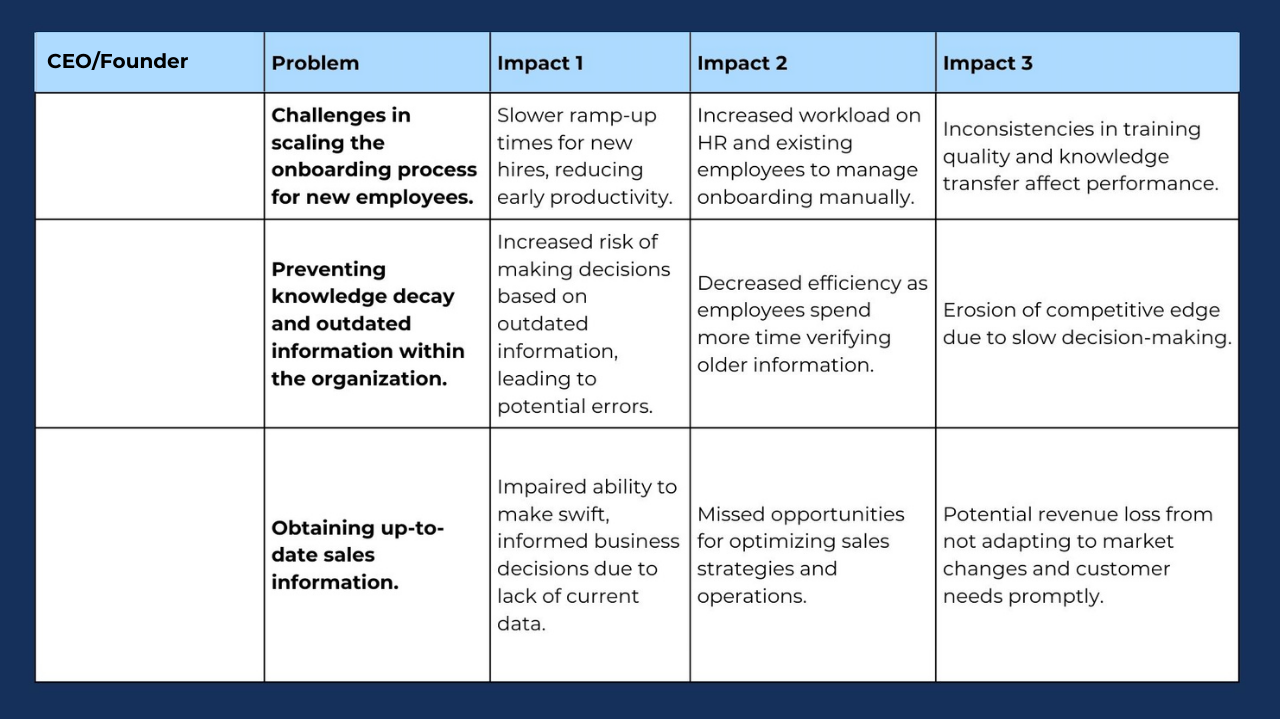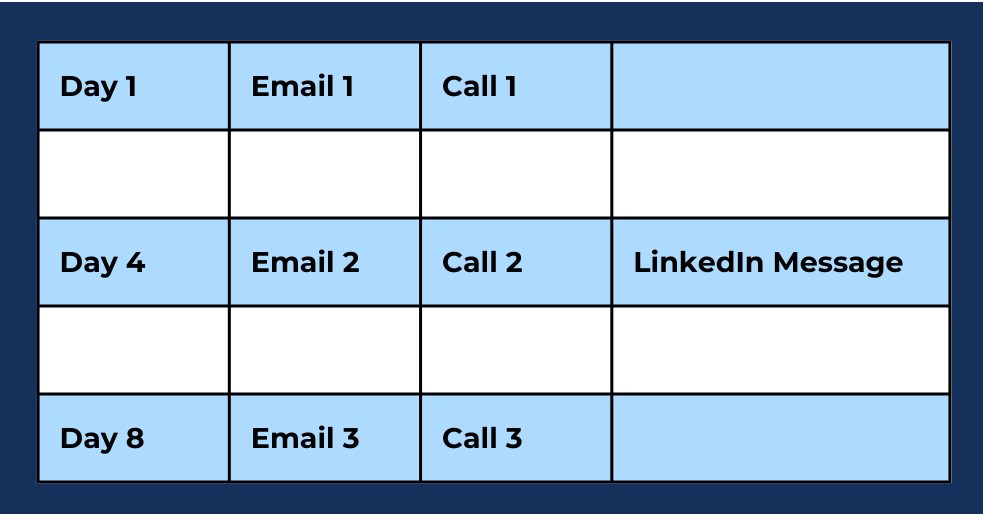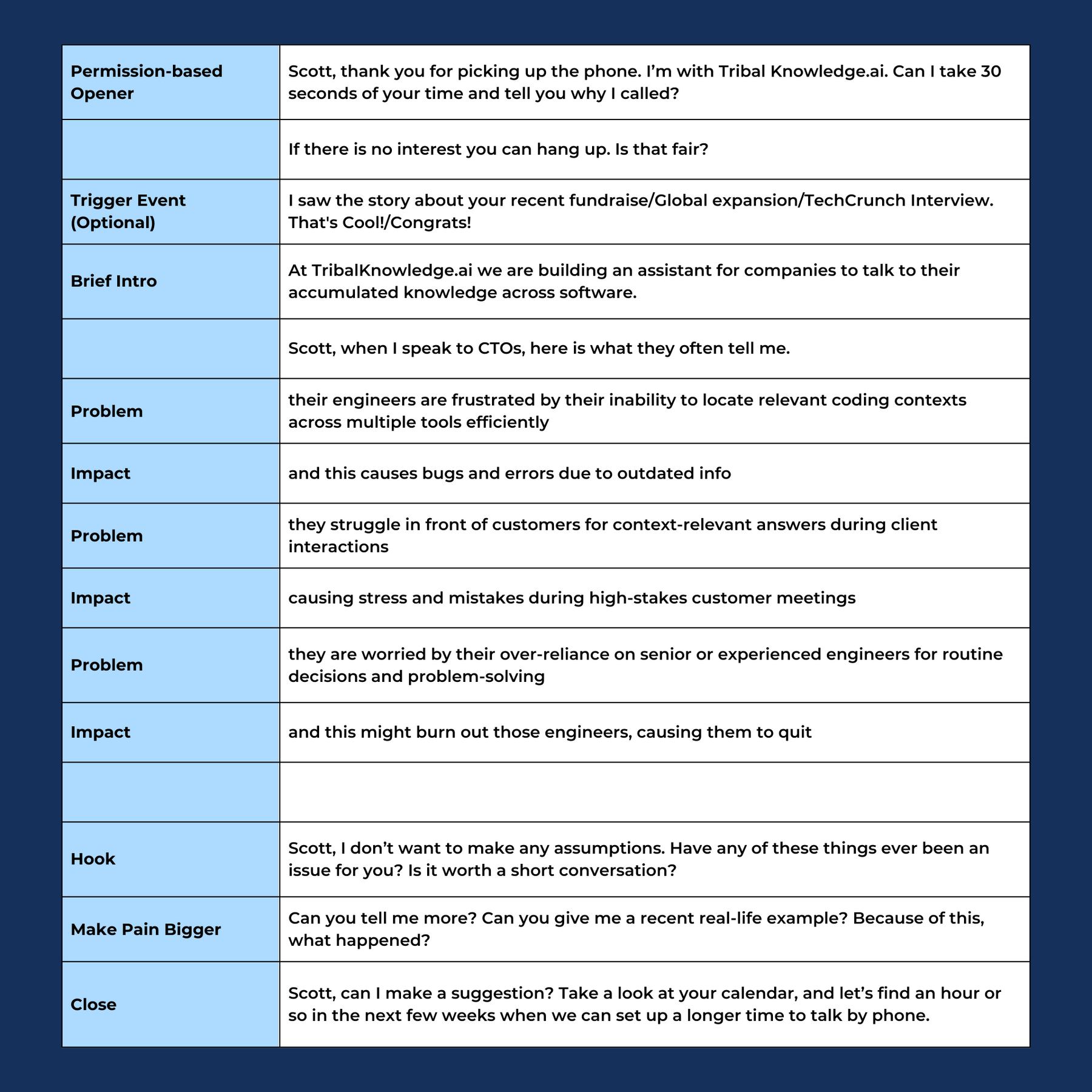You have an idea and a prototype or a minimum viable product. Now, you want to talk to customers to get them to use or buy your product.
What do you do next?
Many founders, especially technical ones, get stuck at this stage. This post attempts to create a tactical guide on the nuts and bolts of finding your first customers and fixing meetings with them via outbound strategies.
We will cover the following topics.
- Define your ICP (Ideal Customer Profile) & Persona
- Create a Persona-Problem-Impact Table
- Non-Scalable Outbound: Personal, Alumni, and Investor networks
- Scalable Outbound: Cold Calling and Cold Emailing
I'll create a fictitious startup, TribalKnowledge.ai, and walk you through these steps. Let’s assume I'm the founder, and the prototype is ready.
What does my startup do - An AI assistant that lets employees search for info/data in Slack, GitHub, Google Drive, Jira, and Confluence using natural language and LLMs.
Define your ICP (Ideal Customer Profile) & Persona
The first step is to define your ICP and Persona. These phrases are often used interchangeably, but we will make a distinction for this article.
An Ideal Customer Profile is a list of quantitative factors that define a company or organization to which you can sell your product. Alternatively, An ICP is a detailed description of the perfect customer (company). Some of the common factors used are below.
- Geography
- Industry
- Employee Count
- Revenue
- Department
- Department size
- Amount Raised
- Technical details like Are they mobile-first, MAUs, etc.
A Persona is a Designation of the person who would use or buy the product. It typically includes details such as:
- Job title and role
- Demographics (seniority, education, technical degrees/certifications)
- Goals and objectives
- Challenges and pain points
- Preferred communication channels
- Decision-making process
- Objections and concerns
I have a hypothesis of who my ICP might be for TribalKnowlege.ai - Software Companies in the US growing headcount 10% year on year with at least 20 Engineers, indicating a Digital Native Business with the engineering team growing 10% year on year.
I entered the above data into a database tool like LinkedIn Sales Navigator (or others like Apollo, Tracxn, and Crunchbase) and created a table of companies in each of the four segments.
Here's what my search returned. Based on my past research, instinct, and customer feedback, I’ve chosen the Mid-Market as ICP 1 and Enterprise as ICP 2.
- SMB/Startup (Employee count 0-200): 1157
- Mid-market (Employee count 200-1000): 426
- Enterprise (Employee count 1000-5000): 109
- Large enterprise (Employee count 5000+): 33
I'll save these two searches on LinkedIn Sales Navigator as Account lists.
I believe my two target Personas are the CTO/Head of Engineering (Persona 1) and the Founders/CEOs (Persona 2) of these companies. This choice should be made after careful consideration. You should talk to people in the industry or, if you are from this industry, have a deep understanding of who your possible target personas are.
I'll search for Persona 1 in my saved Account List of ICP 1. This search gives me ~260 potential leads to go after right away.
Create a Persona-Problem-Impact Table
Early-stage founders risk being so in love with their product or technology that they struggle to think about the sales process from their target persona's perspective.
To fix this, start by creating a table listing the Personas and the problems they face (that your product solves or will soon solve) and then the impact of these problems.
The philosophy is that no one cares about your cool new technology/product/service; they care about their problems and whether you can solve them.
Create the table for your product. It will inform your cold calling and emailing/ messaging strategy.
Each of these problems becomes an input into your Outbound Email Script and Cold Calling Script. You can also use these to create landing page copy!
Now that you have done the hard work of making your Persona lists and have hypotheses of the problems that trouble them, you are ready to shoot off emails to them, right?
No.
You still need to prioritize Non-Scalable Outbound vs Scalable Outbound.
Non-Scalable Outbound
The first step is to focus on non-scalable outbound, reaching out to people in the Persona 1 and Persona 2 lists through referrals and introductions.
You can use three networks - Personal, Alumni, and Investor.
Your personal network includes old colleagues, family, friends, and others from your work life. You can use LinkedIn Sales Navigator to find people in your network who can connect you to your Persona 1 and Persona 2 lists. If you're connected to your investors, this will also reveal the people they can connect you to.
The alumni network includes people who attended your school/college. A BITS founder can search the ‘School’ field for juniors and seniors in his Persona 1 and Persona 2 lists.
Once I have a list of common connections, I'll create a table to track them. Remember to follow up after requesting intros, as people are busy and might forget to reply the first time.
Here's an email template for Alumni Connects, which you can adapt for Personal and Investor connects.
Subject: BITS, Search Tech, Intro
Hi Amit,
I’m Ravi from the 2008 batch of BITS, I am reaching out to request an intro to Emily Quinn—the CEO of FutureNow. I saw you worked with her in your previous role at ZZ inc.
I’m the founder of TribalKnowledge.ai, a search startup funded by XX and YY, with AA and BB as customers. I believe Emily will find our technology immediately useful for her rapidly growing company.
Ravi
P.s - we were recently covered by Techcrunch/Your Story - url.com
Prioritize Non-Scalable Outbound. Our network doesn’t grow much month-on-month, so in all likelihood, you can do this only once. When done with all people in your Persona 1 and Persona 2 lists, move to Scalable Outbound.
Scalable Outbound
Scalable outbound or cold outreach involves reaching out to prospects directly via email, phone, or LinkedIn. The optimal way to do this is to create a sequence.
A sequence involves reaching out to your prospects via multiple channels over 2-3 weeks.
Most founders reach out to a prospect once or twice and then stop, reducing the odds of hearing back. Creating a sequence provides you with multiple entry channels, which is helpful as you are just starting and don’t have enough data on the ideal channel for a prospect.
Also, we do not know their current priority problem, so we have to hit them with all three problems we came up with.
Side Note: Getting Email IDs and Phone Numbers is a solved problem. Tools like Zoominfo, Lusha, and Apollo.io provide reliable data, especially for Western markets. Apollo.io is the cheapest bundle of contact data, email tools, and dialler software.
Also, I know what you are thinking: you’re going to hire that poor Intern to do your cold calling and emailing. Stop. For the first Million USD in revenue, one of the founders should do all the stages in sales from prospecting, outbound, and pitching to closing. Do not delegate this step.
Sample sequence
Cold Email Template
Email 1
Subject: Your Own Google, Context Switch, 2024
Hi Scott,
We have yet to be properly introduced, but I'm Ravi, the Founder of TribalKnowledge.ai. I came across your Series E announcement; congratulations!
The reason for my outreach is to chat about our new product built for you. I suspect like many CTOs your team manages projects across multiple platforms like GitHub and Jira. It's impressive, yet challenging to keep everything aligned.
Many engineering leaders share that finding relevant coding contexts swiftly is a constant struggle, often leading to decreased productivity. Our solution streamlines information retrieval across your tools, cutting down search time by 30%.
Worth a chat?
Cheers!
Ravi,
Founder, TribalKnowledge.ai
---
Email 2
Subject: Stressed Senior Engineers
Hi Scott,
Rapidly growing software teams rely heavily on senior engineers for day-to-day decisions. This must be quite demanding on their time.
We've helped organizations like yours decentralize knowledge, allowing junior staff to make informed decisions independently by querying docs across dozens of internal tools like Github, Confluence, Zendesk etc., thus preventing senior engineer burnout.
Would it be a bad idea to chat further?
Cheers,
Ravi,
Founder, TribalKnowledge.ai
---
Email 3
Subject: Accelerating Your Client Conversations
Hi Example,
In client-facing roles, every second counts. I understand that delays in accessing the right information can impact client satisfaction.
TribalKnowledge.ai helps your engineers retrieve context-relevant answers quickly, boosting confidence during critical interactions. Our clients have noticed a marked reduction in response times and escalations.
Does it make sense to connect and explore this further?
Warm regards,
Ravi,
Founder, TribalKnowledge.ai
---
Important points to note.
- These emails are a starting point. You should A/B test the Subject, first line, call to action, everything.
- These emails should not contain formatting, attachments, or links. Gmail and Outlook view anything other than simple text as signals of a sales/marketing email, and this will lower the chances of landing in the Inbox.
- Make sure to send emails to verified email IDs only (most database tools will tell you the verification status); otherwise, your Email Reputation will crash, and emails will not get delivered.
- For the LinkedIn Step, Add a few important leads to your network. LinkedIn now tracks inMails and Connection requests for spam, so you cannot use them with all leads.
- Tools like Apollo and HubSpot’s emailing tool can help you pull data from LinkedIn into your sequence.
Cold Calling Script
As soon as the email is sent, call them. The broad structure of a call should be as shown below. The left-hand column shows the important parts of the call, and the right-hand column shows how I would execute it for my startup when I call a CTO.
These problems and impacts are the ones we created in the Persona-Problem-Impact step.
Keep an eye on the open rates for your mails. In the SaaS industry, an email open rate of 30% to 50% is considered good.
With a combination of skillfully executed cold emails, cold calls, and a sprinkling of LinkedIn, you could achieve a ~5% meeting rate.
Bonus: Three non-technical pitches
During your outbound journey, you will meet a diverse range of people—alumni, investors, prospects, gatekeepers like Executive Assistants and Receptionists, new hires, and nosy family members.
They will have varying technical expertise, competencies, and interest in your product. So you need the ability to pitch to them differently: Quick and Dirty, Direct, and Professional scale from easy to understand for a layperson to a pitch to a technically competent customer.
First, write the answers to these background questions, which will lead to the pitches.
1. Target audience's problem
Identify the main challenge or pain point of the target audience.
2. Limitations of current solutions
Explain why existing solutions don’t address the problem effectively.
3. Recent advancements enabling new solutions
Highlights advances enabling a new solution.
4. [Product Name]: The innovative solution
Present your product as an innovative solution.
5. How does the solution work
Provide a brief overview of the product's working mechanism and unique features.
6. Evidence of effectiveness (quantitative and qualitative)
Share specific data or testimonials demonstrating the product's effectiveness.
7. Concise conclusion highlighting key benefits
Summarize the main benefits of the product and conclude the pitch.
For TribalKnowledge.ai, this will be the outcome
Target audience's problem
Employees often struggle to quickly access scattered information across tools, applications, and databases, leading to inefficiencies and productivity losses.
Limitations of current solutions
Traditional enterprise search tools are limited in scope and capabilities, often failing to deliver relevant and personalized results quickly and accurately.
Recent advancements enabling new solutions
Advancements in AI, machine learning, and natural language processing enable intelligent search solutions to sift through vast amounts of data across platforms for personalized and contextually relevant information.
TribalKnowledge.ai: The innovative solution
TribalKnowledge.ai is an AI-powered search tool that provides employees with personalized search results by understanding the context and relationships between data across various applications.
How does the solution work
TribalKnowledge.ai provides a unified search experience to help users find information quickly, surfacing insights, documents, and knowledge across their digital workplace by connecting to a wide array of workplace tools and using AI to understand user intent and context.
Evidence of effectiveness (quantitative and qualitative)
Customers praise TribalKnowledge.ai for saving time and reducing the frustration of finding scattered information, leading to increased productivity. Companies using TribalKnowledge.ai report a 30% improvement in search efficiency and collaboration.
Concise conclusion highlighting key benefits
TribalKnowledge.ai enables organizations to maximize their digital workplace potential, allowing employees to quickly access the information they need and improve productivity.
Here are the three versions of the pitch:
Quick & Dirty Version
Finding stuff at work is hard, especially when it's spread across different tools. Most search tools can't keep up. But new AI tech is changing the game. TribalKnowledge.ai makes it super easy to find what you need by connecting to all your apps and using smart search. People love how fast they can find stuff now, making work much easier!
Direct Version
Companies often struggle to find important information scattered across various tools, wasting time. Current search tools often fail. TribalKnowledge.ai's new AI tech connects to your workplace apps, understands what you're searching for, and delivers accurate, personalized results. Users notice improved productivity and smoother teamwork.
Professional Version
Organizations frequently struggle to locate critical information scattered across multiple digital platforms, leading to inefficiencies. Traditional search tools lack the precision and context awareness needed to surface relevant information swiftly. With advancements in LLMs, TribalKnowledge.ai offers a comprehensive solution that seamlessly integrates with various workplace tools, harnessing intelligent search to deliver accurate and personalized results. Companies using TribalKnowledge.ai report a 30% improvement in search efficiency and productivity, empowering teams to work smarter and more collaboratively.




